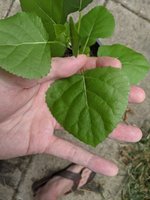The roots of bittersweet tend to have orange to brown thin bark (when a couple years old) and below the orange bark the cambium is bright yellow.
Bittersweet definitely has bonsai potential, once you get a decent trunk. Mine has been taking FOREVER to trunk up. Look around, where you have seedlings, larger plants are probably not too far away.
THe potential ID for this tree is maybe Bittersweet,
maybe Cottonwood
lower probability - Tilia cordata - basswood.
My guess; it is one of the 3 above, a couple more years of growing and it will be easier to figure out which is what.
The European species of Tilia have a good track record for bonsai, in particular "Little Leaf Linden" is quite popular for bonsai. I don't recall seeing the American species being used, though it probably has been.







